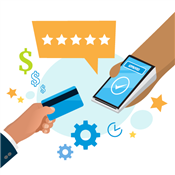Best E-commerce Merchant Account
Looking for an e-commerce merchant account to help expand your business? Read on to see which one could work for you.
 |
It can be hard to choose an e-commerce merchant account provider. You second-guess if you're getting the best processing rates. Then, you wonder if their features can work in the long run.
Not to mention, it's not certain that you'll get approved for an account. So, to lessen the hassle, you can explore the options below.
The best e-commerce merchant accounts are offered by:
- Square for New Businesses or Startups
- Stripe for Large and Established Businesses
- PayPal for International Businesses
- Stax for High-volume Businesses
- PaymentCloud for Customized Processing Solutions
- CDGcommerce for the Best Chargeback Features
- eMerchant Broker for High-risk Businesses
Save Up to 40%
- Flat Monthly Subscription Price, Starting at $99
- 0% Markup on Direct-Cost Interchange
- 24/7 Support
7 Best E-commerce Merchant Accounts
Not all merchant accounts are the same. Each merchant account provider and payment services provider will have their edge in terms of features and processing rates.
| Monthly Fee | Pricing Model | Accept International Payments | |
|---|---|---|---|
| Square | Starts at $0/mo | Flat rate | USD payments only |
| Stripe | No monthly fees | Flat rate (also offers customized pricing packages) | 135+ currencies |
| PayPal | No monthly fees (additional payment features start at $5/mo) | Flat-rate and Interchange-plus | 25 currencies |
| Stax by fattmerchant | Starts at $99 per month | Subscription | USD or CAD only |
| PaymentCloud | Not disclosed - offers customized pricing | Customized | Not disclosed |
| CDG Commerce | No monthly fees for flat-rate and interchange-plus programs; Membership starts at $49/mo (for large volume businesses) |
| Not disclosed |
Let's start with an option for new businesses.
Square: for New Businesses
It's easy to open an account with Square. There's no underwriting process, so even a new e-commerce business can open an account.
Square even lets you create a free online store. It has Afterpay built-in, so your customers can pay in interest-free installments. But you're paid in full right away.
Plus, your Square account integrates with Square POS. So whether you have a physical store or not, some features you can get include inventory management, customer management, shipping, and in-store pickup.
Pros + Cons:
|
|
Plans and Processing Fees:[1]
Square offers a free plan. You'll only have to pay for the processing fees. This makes it budget-friendly for new or small businesses that don't have steady sales. The rates are:
| Online | 2.9% + $0.30 |
| Manual keyed-in | 3.5% + $0.15 |
| Invoicing | 3.3% + 30¢ |
| In-person | 2.6% + $0.10 |
| Afterpay | 6% + 30¢ |
For more advanced features, you can also upgrade to a Plus plan ($29+/mo). Custom pricing is available for large businesses.[2]
Square Reader: Free Mobile Credit Card Reader
- Pay 2.6% + 10¢ Per Swipe for Visa, Mastercard, Discover, and American Express
- Accept Credit Cards Anywhere
- Fast Setup, No Commitments
Stripe: for Large and Established Businesses
Stripe has an extremely customizable user interface, including an embeddable checkout form for e-commerce transactions.
You can also send shareable links and invoices to your customers, or take ACH payments if you prefer.[3] You can even take in-person payments if you purchase a Stripe terminal.
The catch is that customizing Stripe to your liking will require some coding. So you'll need a team of in-house web developers to really make the most out of the customizable UI. That, or you can outsource the work.
Pros + Cons:
|
|
Plans and Processing Fees:[5]
With Stripe, there are no monthly or setup fees. All you'll need to pay for are the per transaction/invoice fees:
| Online payments | 2.90% + $0.30 |
| Keyed-in payments | 3.40% + $0.30 |
| Invoicing | 0.4% |
| In-person payments | 2.70% + $0.05 |
| Tap to pay | $0.10 |
Online Payment Processing
- Accept payments worldwide and automate payouts and financial workflows seamlessly
- Grow with confidence: Whether you're running an e-commerce store, subscription service, or marketplace, Stripe adapts to any business model
- Trusted by millions: From startups to Fortune 500 companies, Stripe powers businesses of every size
- Predictable costs: Transparent flat-rate pricing with no setup fees or monthly charges – pay only for what you use
- Enable more sales: Support credit cards, mobile wallets, and 135+ international payment methods
- Developer-friendly tools: Integrate payments quickly with Stripe's intuitive APIs and documentation
PayPal: for International Businesses
PayPal is convenient if you have customers from other countries. After all, it's one of the most popular payment services worldwide. It lets you take PayPal, Venmo, credit card, and debit card payments, offering more choices to your customers.
You can also send payment links, QR codes, or invoices.[7] [8] These can make it easier for your customers to pay right away.
When it comes to setting up your website, PayPal works with many e-commerce platforms like Shopify, Big Commerce, and WooCommerce. They also have POS equipment available for your physical store.
Pros + Cons:
|
|
Plans and Processing Fees:
Creating a business account with PayPal is free. You'll only need to pay for processing fees:[11]
| PayPal & Venmo payments | 3.49% + $0.49 |
| Online debit/credit card | 2.59% + $0.49 |
| Online debit/credit card (with chargeback protection) | 2.99% + $0.49 |
| QR code payments | 2.29% + $0.09 |
You'll need a merchant account to take online payments from your e-commerce store. Without one, you'll at least have to apply to a payment service provider for a "sub-merchant" account. PayPal, Square, and Stripe are some examples of payment service providers.
Stax: for High-volume Businesses
Unlike Stripe, Stax lets you customize your shopping cart without the need for coding. But if you don't want to get too into it, there's also a pre-made cart you can use.
Stax also integrates with many online payment gateways like BigCommerce, WooCommerce, Magento, etc. So you may find an option you already prefer.
The account comes with many business-related features, too, like inventory management and reporting. This allows you to make data-driven decisions when it comes to improving your business.
Pros + Cons:
|
|
Plans and Processing Fees:[12]
Stax offers flat-rate subscription plans. This is much easier to budget compared to pay-as-you-go plans. The price will only change depending on your transaction volume.
| $250,000/year or less | $99/month |
| $250,000-$500,000/year | $199/month |
| Over $500,000/year | Custom pricing |
Save Up to 40%
- Flat Monthly Subscription Price, Starting at $99
- 0% Markup on Direct-Cost Interchange
- 24/7 Support
PaymentCloud: for Customized Solutions
PaymentCloud is a merchant account provider that supports low-risk to high-risk businesses. It's one of the best processors overall (not just for e-commerce).
That said, to accept online payments, PaymentCloud provides you:
- Integrated payment gateways
- Shopping carts
- Virtual terminals
Your payment gateway will already be PCI-compliant and come with security features like fraud protection, data encryption, and 3D Secure. Payment gateway integrations include Authorize.net, NMI, USAePay, and Cybersource.
These gateways integrate with the most popular shopping carts, too, like BigCommerce, WooCommerce, Shopify, Magento.
Pros + Cons:
|
|
Plans and Processing Fees:
PaymentCloud offers customized pricing, so you'll have to contact them for a quote.
Your processing rates will depend on several factors, like your processing history, credit history, and sales volume.
You can try to ask for interchange-plus pricing since it's typically more affordable than flat rates. The average interchange rates range from 1.7% to 2%.
High Risk? No Problem
- Competitive Options for Payment Processing at All Risk Levels
- Fast Funding
- No Setup/Hidden Fees
- No Minimum Credit Score
- All Industries Accepted
CDG Commerce: for Chargeback Features
CDG Commerce is one of the more established merchant account providers, having over 20 years of experience.
It can help you accept payments on your website, in your physical location, and even on the go. But e-commerce businesses can make the most of it given the many useful chargeback tools it offers.
For example, Chargeback Defender increases your chances of rebuttal, where experts will help you provide successful responses to your disputes.
The Chargeback Collector, on the other hand, gets you your money back even after losing a chargeback. You can also protect your business from losses through Fraud Loss Reimbursement.
Pros + Cons:
|
|
Plans and Processing Fees:[13]
CDG Commerce offers 3 pricing models to choose from.
| Flat-rate Pricing | |
|---|---|
| Online payments | 3.50% + $0.40 per transaction |
| In-person payments | 2.90% + $0.30 per transaction |
| Mobile payments | 2.90% + $0.30 per transaction |
| Interchange-plus Pricing | |
| Online businesses | Interchange + 0.30% + $0.15 per transaction |
| Retail businesses | Interchange + 0.25% + $0.10 per transaction |
If you're a large business or a small business with large sales volumes, membership pricing may be more suitable.
| Wholesale or Membership Pricing | |||
|---|---|---|---|
| Basic | $49/mo | Process up to $25,000/mo | Interchange + $0.10 per transaction |
| Standard | $79/mo | Process up to $75,000/mo | Interchange + $0.10 per transaction |
| Plus | $99/mo | Process up to $200,000/mo | Interchange + $0.07 per transaction |
| Premium | $199/mo | Unlimited Processing | Interchange + $0.05 per transaction |
eMerchant Broker: for High-risk Businesses
As a high-risk business, finding an e-commerce merchant account provider can be extra challenging. But with eMerchant Broker (EMB), you'll get a higher chance for approval. You might even get approved in just a day or two.
High-risk industries they support include CBD, e-cigarettes, online gaming, and the adult industry. They also support businesses with poor credit or those who are just beginning to build one.
EMB integrates with many e-commerce platforms like Wix, Shopify, WooCommerce, and more. So if you plan on setting up an account, you'll have many integrations at the ready—which is always a plus in our book.
Pros + Cons:
|
|
Plans and Processing Fees:
Unfortunately, EMB isn't transparent with their fees. You'll have to contact them to get a quote. This is likely because many factors will affect your processing rate as a high-risk business.
High Risk? No Problem
- Competitive Options for Payment Processing at All Risk Levels
- Fast Funding
- No Setup/Hidden Fees
- No Minimum Credit Score
- All Industries Accepted
You're considered a high-risk business if you have a higher potential for chargebacks or fraud. Because these businesses are deemed risky, most payment processors avoid them. It's important to look at high-risk payment processors, like eMerchant Broker, since they may specialize in your industry.
What is an e-commerce merchant account?
An e-commerce merchant account is what you use to accept debit cards and credit card payments for your online store. It's also a "holding account" that keeps your money before it gets transferred to your business bank account.
That said, a merchant service provider typically offers an all-in-one service. You can often process mobile payments (mobile merchant account) or in-person payments (retail merchant account) from your physical store while taking card payments from your website.
Merchant Account Providers vs. PSPs
You can technically accept debit and credit card payments on your website even without your own merchant account. You just need to work with Payment Service Providers (PSPs).
Merchant account providers offer you your own merchant account with your own Merchant ID (MID). This MID is unique to your business and serves as an "address" to where the funds are sent.
Payment Service Providers (PSPs), on the other hand, don't offer you a merchant account. Instead, they place your business, together with other businesses, under one "umbrella account"—a single merchant account.
Why do you need a merchant account?
Having your own merchant account is a more secure option. Accounts with PSPs are more susceptible to holds or freezes. But to get a merchant account, you'll have to go through an underwriting process (which isn't necessary for PSPs).
Square, PayPal, and Stripe are actually payment service providers, while Stax and eMerchant Broker are real merchant account providers. However, all of them will be able to help you take online payments for your business.
You'll need a merchant account, which is a bank account used to process cards and other online payments. After being pulled from the customer's bank account, the money from a transaction is held in this merchant account.
E-commerce Merchant Account Services
E-commerce merchant account providers offer a wide variety of services. Aside from accepting credit and debit card payments, here are other features you can get:
- Shopping Cart and Checkout
Some providers offer pre-built shopping carts or checkout while others let you customize them yourself. They may even include other features like gift card options and abandoned cart email reminders. - POS System
Merchant account providers typically have integrated POS systems. With it, you can accept debit and credit card payments online and in person.You'll also have your sales information synced in real time. Just purchase POS hardware for a complete setup.
- Website Builder or Integrations
Some payment service providers offer website builders or integrations for various e-commerce platforms. You may be able to create a new online store or connect a shopping cart to an existing website. - Social Media Integrations
A social media presence is a must for any hopeful business owner. Good thing some merchant account providers let you sell on your socials like Facebook or Instagram. But you can also just share payment links or QR codes on them. - Management Features
You may get features on inventory management, employee management, and customer management. These can help you run your business more smoothly on the back end. - Reporting
Looking to grow your business even further? Use different reports to make data-driven decisions. These are usually accessible from your merchant account dashboard.
A retail merchant account is more suitable for those with physical stores, as you'll typically need POS hardware to accept card payments. For e-commerce merchant accounts, no hardware is needed as it caters to online businesses.
How do you choose an e-commerce merchant account?
It isn't always easy to apply for a merchant account, especially with the underwriting process. So before you select a provider, here are a few factors you should consider:
- Accepted Payment Methods
What payment methods do you plan to take aside from credit and debit cards? You may also want other features like invoicing and ACH processing.For in-person sales, you can typically accept contactless payments such as Apple Pay and Google Pay. But you may need to purchase additional card readers to do so.
- Fees and Pricing Structure
Aside from transaction fees, merchant accounts typically come with other fees, such as monthly fees, PCI compliance fees, chargeback fees, etc.Consider the pricing structure most suitable for your business. Interchange plus pricing may be better for small businesses, while subscription plans might fit larger businesses more.
- Payment Gateway
A payment processor can offer multiple payment gateways. These payment gateways could also have their own fees. If you have a preferred option, be sure to inquire about it. - Security
A merchant services provider should offer end-to-end encryption/tokenization to ensure no one can store sensitive data. They may also offer advanced fraud detection tools, especially if you're a high-risk business.Also, merchant accounts should follow the requirements of the PCI Security Standards Council. Check if the provider is PCI-compliant and if there are other fees associated with it.
It's even helpful if you can set user permissions. That way, only essential staff can access customer information.
Did you know?
Companies report a lot of fraud instances. And about 70% of companies use 3 or more anti-fraud tools to help solve this problem.[15] Below are the trends you need to watch out for.Fraudulent Activity Fraud Trend Customers abusing promotions 52%[16] Chargeback abuse 61%[17] Account takeover or stolen credentials 131%[18] - Integrations
There may be integrations for e-commerce platforms like Shopify or business tools like QuickBooks. If you think integrations like these can help your business, check which are available with your merchant account. - Scalability
Make sure that the merchant account provider can cater to your business as it grows. This could either be in the form of transaction volume or add-ons. - Contract
Many payment processors offer month-to-month contracts with no termination fees. But high-risk businesses may be tied to long-term contracts (2-3 years). Consider the terms when you budget. - Customer Support
Whether it be for chargebacks, refunds, or other payment problems you encounter, it always helps to have access to great customer service. You can test this out by inquiring as much as you can when looking around for a merchant services provider.
Methodology
When analyzing different e-commerce merchant accounts, we considered the following:
- Services they offer
- Scalability
- Pricing structure
- Suitable type of business
Although the ability to accept card payments online is the main draw of an e-commerce merchant account, we wanted to know what additional features came with one. More payment options equals more convenience for your customers.
We also checked if different pricing plans let you use the account long-term. To cater to varying business sizes, we looked at the best pay-as-you-go plans and subscription pricing options.
Generally, we made sure there was an option for everyone—new, established, or even high-risk businesses. The best for each type won't always be the same provider.
What the Experts Say
CreditDonkey asked a panel of industry experts to answer readers' most pressing questions. Here's what they said:
Bottom Line
It's not a one-size-fits-all solution. To find a suitable eCommerce merchant account, consider your business needs first.
Don't just focus on finding the cheapest processing fees, either. Security features and scalability are critical, too.
Remember, these merchant account providers are supposed to help your business grow. Go for one that not only allows you to take online payments but does so in a way that's convenient for you and your customers.
References
- ^ Square. Payments, Retrieved 05/15/2023
- ^ Square. Pricing, Retrieved 8/13/2023
- ^ Stripe. Payment links, Retrieved 8/27/23
- ^ Stripe. Currencies, Retrieved 8/27/23
- ^ Stripe. Pricing, Retrieved 05/15/2023
- ^ Stripe. Instant Payouts, Retrieved 8/27/23
- ^ Paypal. Invoice, Retrieved 8/27/23
- ^ Paypal. QR code, Retrieved 8/27/23
- ^ Paypal. Where's my withdrawal?, Retrieved 8/27/23
- ^ Paypal. About us, Retrieved 8/27/23
- ^ PayPal. PayPal Merchant Fees, Retrieved 8/13/2023
- ^ Stax. Pricing, Retrieved 05/15/2023
- ^ CDGCommerce. Pricing, Retrieved 02/10/24
- ^ BBB. EMB, Retrieved 8/27/23
- ^ Ekata. Protecting your small-to-medium business against ecommerce fraud in 2023, Retrieved 04/15/24
- ^ Ekata. Reining in Promo Fraud, Retrieved 04/15/24
- ^ Chargebacks911. Friendly Fraud Costs, Retrieved 04/15/24
- ^ Sift. Account takeover data, trends, and insights, Retrieved 04/15/24
Write to Karen Eloriaga at feedback@creditdonkey.com. Follow us on Twitter and Facebook for our latest posts.
Note: This website is made possible through financial relationships with some of the products and services mentioned on this site. We may receive compensation if you shop through links in our content. You do not have to use our links, but you help support CreditDonkey if you do.
Not sure what is right for your business?
|
|
|
Answer a few short questions in our credit card processing quiz to receive tailored recommendations to help you keep more profits.
|
|
|








